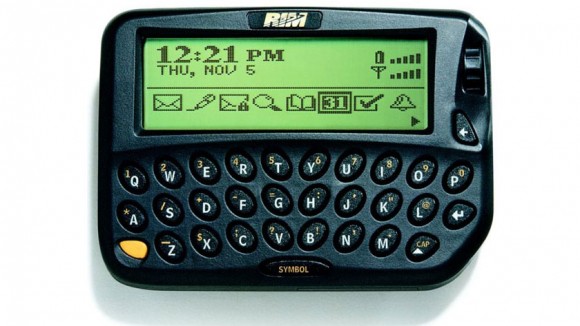In 1984, Mike Lazaridis, an engineering student at the University of Waterloo, and Douglas Fregin, an engineering student at the University of Windsor, founded an electronics and computer science consulting company called Research In Motion, or RIM. For years the company tinkered in obscurity, until it focused on a breakthrough technology: an easy, secure, and effective device that allowed workers to send and receive e-mails while away from the office. They called it the BlackBerry.
RIM grew into one of the world’s most valuable tech companies. The BlackBerry became the indispensable accessory of business executives, heads of state, and Hollywood celebrities—until iPhone and Android came along and spoiled the party. Today the company, which has been renamed, simply, BlackBerry (BBRY), is burning through cash as sales keep falling. On Nov. 21, BlackBerry shares closed at just above $6, the lowest it’s been in almost 15 years.
Over the last two months, Bloomberg Businessweek spoke to dozens of current and former BlackBerry employees, vendors, and associates. Here is their account of the thrill of BlackBerry’s ascension—and the heartache of watching its demise.
In 1992, Chief Executive Officer Lazaridis hires Jim Balsillie, a Harvard Business School graduate, to help manage the cash-strapped business. Balsillie takes out a second mortgage and invests $250,000 in return for a one-third stake and soon becomes co-CEO. (Balsillie and Lazaridis declined to be interviewed for this story.)
 Aaron Harris/CP Photo/AP PhotoCo-CEOs Lazaridis (left) and Balsillie in 2003
Aaron Harris/CP Photo/AP PhotoCo-CEOs Lazaridis (left) and Balsillie in 2003
Patrick Spence, senior vice president and managing director for global sales and marketing, 1998-2012: Jim was really strategic in terms of how he was thinking and really ambitious in terms of what we wanted to do. You don’t meet many Canadians that are ambitious in that kind of way.
Mousseau: We were creating all these random products over wireless, [but] none of them had all the dominoes in place to really succeed. They were just interesting. Mike is an electrical engineer. That was his forte, his love. We eventually decided to replace a very large bulky radio modem that IBM (IBM) used for [basic personal communication] service. This was the RIM 900. It was a clamshell device. Some would affectionately call it the bullfrog. We sold a lot of them.
Jim Estill, member of the board, 1997-2010: In the early days at RIM, people had no idea what a smartphone was. People had no idea what two-way pagers were. But they had such a cool factor. You’d take one out, and everybody would want to touch it and play with it and see what it was.
Mousseau: Mike and I and a few others got obsessed with auto-forwarding our Exchange mailbox messages to our belts. But at that time you couldn’t reply to anything. So one day, Mike came in and said he had decided to nix all the 30 software projects that we were spinning our wheels on. He said, “We’re going to create a solution to this two-mailbox problem.”
RIM goes public in 1997, listing on the Toronto Stock Exchange; shares would begin trading on Nasdaq two years later. Balsillie establishes “the doughnut rule,” in which employees caught talking about the share price would have to buy doughnuts for everyone at the company. The following year the company releases the RIM 950 wireless device, featuring a miniature qwerty keyboard.
Bruce Poon Tip, Canadian entrepreneur, founder of G Adventures: I was part of a group called the Innovators Alliance. Jim [Balsillie] came in and held up this prototype that was in the shape of a blackberry. It was dark blue and had grooves where the keys would be. When he said, “It’s called a BlackBerry,” people started rolling their eyes. They thought it was a stupid name. This was the height of the dot-com boom. He had this dream of people getting e-mails on the move, and the feeling at the time was, “Why would anyone want their e-mails away from the office?”
Read more at Businessweek

